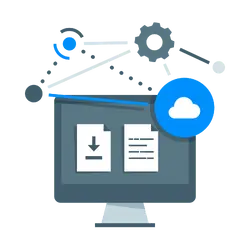The Rising Threats: What’s Keeping Cybersecurity Experts Up at Night?
As we roll through 2025, one thing is clear: cybersecurity is no longer just an IT issue; it’s a frontline battle for businesses, governments, and individuals alike. It seems like every day, the news is flooded with headlines about a new data breach or a devastating ransomware attack. But what exactly are the biggest cybersecurity threats of this year? And more importantly, what can you do to protect yourself?
1. Ransomware Attacks: A Growing Menace
If you thought ransomware attacks were a thing of the past, think again. These malicious software programs that hold your data hostage for a ransom payment are more sophisticated than ever. Take the recent attack on a major hospital chain in the U.S., where hackers shut down critical systems and demanded millions of dollars in cryptocurrency. The result? Delayed surgeries, compromised patient data, and a heavy financial toll.
What makes ransomware so dangerous in 2025 is its increasing ability to target not just large corporations but also small businesses and individuals. Hackers have become more creative, even using social engineering techniques to trick employees into clicking malicious links. It’s no longer just about coding; it’s about exploiting human error.
2. AI-Powered Cyber Attacks: The Rise of the Machines
We’ve all heard about the potential of artificial intelligence in reshaping industries, but let’s face it: it’s also making hackers a lot smarter. AI and machine learning algorithms are now being used to carry out cyber attacks with a level of precision and speed that was previously unthinkable.
For instance, in 2025, researchers discovered a new AI-driven attack where a hacker used deep learning models to automatically scan for vulnerabilities in software systems. The machine could then tailor its attack strategy to exploit those weaknesses more effectively than any human hacker could. The scariest part? The machine learns and adapts with every attack, making it even harder to predict and stop.
3. Internet of Things (IoT) Vulnerabilities: Connecting Everything, Leaving Everything Exposed
The Internet of Things (IoT) is here to stay, and while it has made our lives more convenient, it has also opened up new doors for hackers. Smart home devices, connected cars, and even wearable health monitors are increasingly vulnerable to cyber attacks. Hackers are no longer just after your bank account information; they’re after your personal data, your home, and sometimes even your life.
Take the example of a smart thermostat. It may seem harmless, but if it’s poorly secured, it can serve as an entry point into your home’s entire network. Once inside, a hacker could potentially access your security cameras, disable your alarm system, and even unlock your doors. And it’s not just the devices themselves; it’s the fact that many of these IoT devices are constantly sending data to cloud servers, making them ripe for interception.
4. Phishing and Social Engineering Attacks: Not Just Your Average Scam
Phishing has been around for years, but in 2025, it’s taken a darker turn. It’s no longer just about fake emails from Nigerian princes offering millions of dollars. Today’s phishing attacks are highly targeted, often personalized, and designed to exploit the smallest vulnerabilities in human behavior.
One example? Spear-phishing, a type of attack where hackers research a specific individual or organization to craft an email that seems completely legitimate. In some cases, the hacker might even impersonate a trusted colleague or boss, making it nearly impossible for the recipient to detect the fraud.
Phishing isn’t just limited to email either. SMS phishing (or “smishing”) and voice phishing (or “vishing”) are on the rise, with hackers using text messages and phone calls to deceive individuals into divulging sensitive information. The tactics are becoming so sophisticated that it’s becoming harder to tell the difference between a real message and a fake one.
5. Cloud Security Risks: The Pitfalls of Digital Transformation
More and more businesses are moving their operations to the cloud, and while the benefits are clear, so are the risks. Cloud services are often seen as highly secure, but they are far from immune to cyber threats. In fact, many cloud-related attacks are the result of misconfigurations or human errors.
One significant threat is the exposure of sensitive data due to improper access controls. Take the case of a well-known company that recently suffered a data breach because an employee accidentally left an AWS S3 bucket open to the public. In this instance, millions of sensitive documents were exposed, including customer records and internal emails. And the worst part? It could have been easily prevented with a simple review of access permissions.
But it’s not just the mistakes of employees or administrators that make the cloud vulnerable. Hackers are increasingly targeting cloud service providers themselves. A single vulnerability in a cloud provider’s system can give cybercriminals access to a wide range of customers.
Conclusion: Staying One Step Ahead
The cybersecurity threats of 2025 may seem daunting, but the good news is that there are steps we can all take to protect ourselves. From regularly updating software and educating ourselves on the latest phishing tactics, to ensuring that our devices are securely configured and using multi-factor authentication, small actions can go a long way in safeguarding our digital lives.
Cybersecurity isn’t a one-time fix, it’s an ongoing effort. By staying informed and vigilant, we can reduce the risk of falling victim to these ever-evolving threats. After all, the best way to fight back against hackers is to be just as smart, if not smarter, than they are.
Key Takeaways
- Ransomware attacks are still a major threat, and they’re getting more targeted and sophisticated.
- AI-driven attacks are becoming a reality, making cyber threats more adaptive and harder to stop.
- IoT vulnerabilities present new opportunities for hackers to infiltrate our lives and homes.
- Phishing is becoming more personalized and harder to detect, with new forms like smishing and vishing on the rise.
- Cloud security risks are real and can expose sensitive data if not properly managed.
Ultimately, the best defense against cyber threats is awareness, preparation, and a willingness to adapt. Keep learning, keep securing, and keep protecting yourself online.



